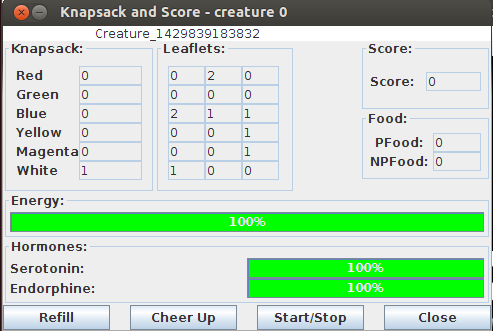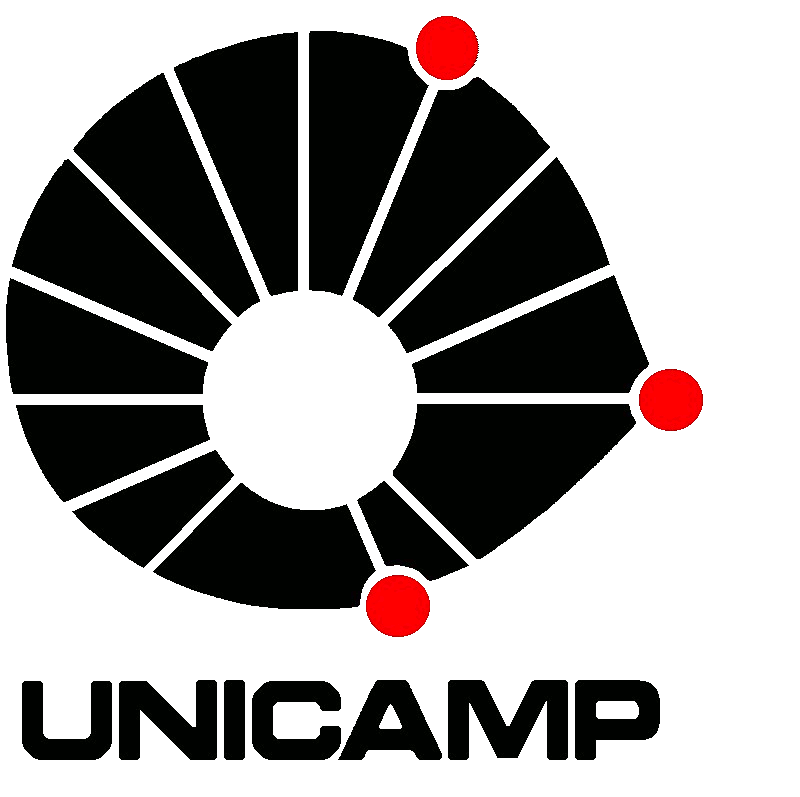- Relatório 1 - Introdução
- Relatório 2 - SOAR: Controlando o WorldServer3D - Atividade 1
- Relatório 2 - SOAR: Controlando o WorldServer3D - Atividade 2
- Relatório 3 - Clarion: Controlando o WorldServer3D
- Relatório 4 - LIDA: Exemplos de Implementação Prática
- Relatório 5 - Projeto LIDA: Controlando o WorldServer 3D
You are here
Relatório 2 - SOAR: Controlando o WorldServer3D - Atividade 2
Atividade 2
Objetivo
O objetivo da simulação no WorldServer é capturar os cristais e ganhar pontos. A criatura deve capturar os critais que estão especificados no seu leaftlet (Figura 1) e fazer a entrega no Delivery Spot. Ou seja, a criatura deve colocar em sua sacola apenas os cristais da cor e quantidade especificada, dirigir-se ao ponto de entrega e fazer a entrega.

Figura 1 - Leaflet da criatura no WorldServer3D
Modificações no DemoSOAR
Foi necessário modificar o DemoSOAR para que ele pudesse trazer o leaflet do WorldServer e evia-lo ao SOAR de uma forma que fosse possível a execução das regras.
Para fazer a leitura do leaflet, foi utilizado o WS3DProxy alterando o método prepareAndSetupCreatureToSimulation() da classe SimulationTask
simulationCreature.setLeafletList(creature.getLeaflets());
Para montar a estrutura do leaflet e envia-lo ao SOAR foi utilizada a classe SoarBridge, alterando o método setupStackHolder():
if (!creatureParameter.getLeafletList().isEmpty() && creatureLeaflet == null){ creatureLeaflet = agent.CreateIdWME(creature, "LEAFLET"); Map<String, Integer> colors = new HashMap<String, Integer>(); for(Leaflet leaflet: creatureParameter.getLeafletList()){ HashMap collect = leaflet.getWhatToCollect(); Iterator it = collect.entrySet().iterator(); while (it.hasNext()) { Map.Entry pair = (Map.Entry)it.next(); if (colors.get((String)pair.getKey()) == null){ colors.put((String)pair.getKey(), (Integer)pair.getValue()); }else{ colors.put((String)pair.getKey(), colors.get((String)pair.getKey()) + (Integer)pair.getValue()); } } } Iterator it2 = colors.entrySet().iterator(); while (it2.hasNext()) { Map.Entry pair = (Map.Entry)it2.next(); System.out.println(pair.getKey() + ":"+ pair.getValue()); Identifier entity = agent.CreateIdWME(creatureLeaflet, "ITEM"); agent.CreateStringWME(entity, "COLOR", (String)pair.getKey()); agent.CreateIntWME(entity, "QTY", (Integer)pair.getValue()); }}Para que a criatura pudesse ralizar a entrega do leaflet, é necessário incluir o tratamento para o comando DELIVER.
No método processResponseCommands da classe SimulationTask, foi incluido um novo token de retorno, para que quando o SOAR retornar este comando, o mesmo possa ser enviado ao WorldServer:
case DELIVER: processDeliverCommand((SoarCommandDeliver)command.getCommandArgument()); break; O comando DELIVER e o Id do leaflet a ser entregue, será passado para o WorldServer através do WS3DProxy.
private void processDeliverCommand(SoarCommandDeliver soarCommandDeliver) throws CommandExecException{ if (soarCommandDeliver != null) { c.deliverLeaflet(soarCommandDeliver.getLeafletId()); } else { throw new NullPointerException("soarCommand is null"); }}Também é necessário modificar o SoarBridge para montar o parâmetro do comando DELIVER:
case DELIVER: String leafletId = null; command = new SoarCommand(SoarCommand.CommandType.DELIVER); SoarCommandDeliver commandDeliver = (SoarCommandDeliver)command.getCommandArgument(); if (commandDeliver != null) { leafletId = pCommand.GetParameterValue("LeafletID"); if (leafletId != null) { commandDeliver.setLeafletId(leafletId); } commandList.add(command); } break;Também é necessário modificar as regras (soar-rules.soar) para que ele leve em consideração as cores e quantidades dos cristais especificados no leaftlet da criatura ao decidir qual cristal capturar.
Regra para propor mover-se pela primeira vez a um cristal que esteja no leaflet, ou seja, quando o atributo GOT não existir para um item do leaflet.
sp {propose*move*jewel*firsttime (state <s> ^io.input-link <il>) (<il> ^CREATURE <creature>) (<creature> ^MEMORY <memory>) (<memory> ^ENTITY <entityInMemory>) (<creature> ^POSITION <creaturePosition>) (<creaturePosition> ^X <creaturePositionX>) (<creaturePosition> ^Y <creaturePositionY>) (<entityInMemory> ^TYPE JEWEL) (<entityInMemory> ^X <entityInMemoryPositionX>) (<entityInMemory> ^Y <entityInMemoryPositionY>) (<entityInMemory> ^NAME <entityInMemoryName>) (<entityInMemory> ^COLOR <entityInMemoryColor>) (<creature> ^LEAFLET <leaflet>) (<leaflet> ^ITEM <item>) (<item> ^COLOR <colorItem>) (<item> ^QTY <jewelQty> > 0) -(<item> ^GOT <gotQty>) (<entityInMemory> ^COLOR <colorItem>) --> (<s> ^operator <o> +) (<o> ^name moveJewel) (<o> ^parameter <jewel>) (<jewel> ^distance (sqrt (+ (* (- <creaturePositionX> <entityInMemoryPositionX>) (- <creaturePositionX> <entityInMemoryPositionX>)) (* (- <creaturePositionY> <entityInMemoryPositionY>) (- <creaturePositionY> <entityInMemoryPositionY>))))) (<jewel> ^X <entityInMemoryPositionX>) (<jewel> ^Y <entityInMemoryPositionY>) (<jewel> ^NAME <entityInMemoryName>) (<jewel> ^COLOR <entityInMemoryColor>)}Regra para propor mover-se a um cristal que esteja no leaflet e o número de elementos capturados (GOT) daquela cor não ultrapassar a quantidade especificada no leaflet (QTY).
sp {propose*move*jewel (state <s> ^io.input-link <il>) (<il> ^CREATURE <creature>) (<creature> ^MEMORY <memory>) (<memory> ^ENTITY <entityInMemory>) (<creature> ^POSITION <creaturePosition>) (<creaturePosition> ^X <creaturePositionX>) (<creaturePosition> ^Y <creaturePositionY>) (<entityInMemory> ^TYPE JEWEL) (<entityInMemory> ^X <entityInMemoryPositionX>) (<entityInMemory> ^Y <entityInMemoryPositionY>) (<entityInMemory> ^NAME <entityInMemoryName>) (<entityInMemory> ^COLOR <entityInMemoryColor>) (<creature> ^LEAFLET <leaflet>) (<leaflet> ^ITEM <item>) (<item> ^COLOR <colorItem>) (<item> ^QTY <jewelQty>) (<item> ^GOT <gotQty> < <jewelQty>) (<entityInMemory> ^COLOR <colorItem>) --> (<s> ^operator <o> +) (<o> ^name moveJewel) (<o> ^parameter <jewel>) (<jewel> ^distance (sqrt (+ (* (- <creaturePositionX> <entityInMemoryPositionX>) (- <creaturePositionX> <entityInMemoryPositionX>)) (* (- <creaturePositionY> <entityInMemoryPositionY>) (- <creaturePositionY> <entityInMemoryPositionY>))))) (<jewel> ^X <entityInMemoryPositionX>) (<jewel> ^Y <entityInMemoryPositionY>) (<jewel> ^NAME <entityInMemoryName>) (<jewel> ^COLOR <entityInMemoryColor>)}Regra para capturar um cristal que esteja no leaflet e ainda nao tenha sido capturado nenhum daquela cor, ou seja, o atributo GOT nao existe.
sp {apply*get*jewel*firsttime (state <s> ^operator <o> ^io <io>) (<io> ^input-link <il>) (<io> ^output-link <ol>) (<o> ^name getJewel) (<o> ^parameter.NAME <jewelName>) (<il> ^CREATURE <creature>) (<creature> ^MEMORY <memory>) (<memory> ^COUNT <quantity>) (<memory> ^ENTITY <memoryEntity>) (<memoryEntity> ^NAME <memoryEntityName> <jewelName>) (<creature> ^LEAFLET <leaflet>) (<leaflet> ^ITEM <item>) (<item> ^COLOR <colorItem>) -(<item> ^GOT <gotQty>) (<memoryEntity> ^COLOR <colorItem>) --> (<ol> ^GET <command>) (<command> ^Name <jewelName>) (<memory> ^COUNT <quantity> - ^COUNT (- <quantity> 1)) (<memory> ^ENTITY <memoryEntity> -) (<item> ^GOT 1)} -> Inicializa o atributo GOTRegra para capturar o cristal que esteja no leaflet e o número de elementos capturados (GOT) daquela cor não ultrapassar a quantidade especificada no leaflet (QTY).
sp {apply*get*jewel (state <s> ^operator <o> ^io <io>) (<io> ^input-link <il>) (<io> ^output-link <ol>) (<o> ^name getJewel) (<o> ^parameter.NAME <jewelName>) (<il> ^CREATURE <creature>) (<creature> ^MEMORY <memory>) (<memory> ^COUNT <quantity>) (<memory> ^ENTITY <memoryEntity>) (<memoryEntity> ^NAME <memoryEntityName> <jewelName>) (<creature> ^LEAFLET <leaflet>) (<leaflet> ^ITEM <item>) (<item> ^COLOR <colorItem>) (<item> ^GOT <gotQty>) (<memoryEntity> ^COLOR <colorItem>) --> (<ol> ^GET <command>) (<command> ^Name <jewelName>) (<memory> ^COUNT <quantity> - ^COUNT (- <quantity> 1)) (<memory> ^ENTITY <memoryEntity> -) (<item> ^GOT <gotQty> - (+ <gotQty> 1)) -> Incrementa o atributo GOT } Para evitar que a criatura fique bloqueada por um cristal indesejado, a regra abaixo permite a captura de cristais que estao no leaflet, apenas se estiverem proximas:
sp {apply*get*jewel*noleaflet (state <s> ^operator <o> ^io <io>) (<io> ^input-link <il>) (<io> ^output-link <ol>) (<o> ^name getJewel) (<o> ^parameter.NAME <jewelName>) (<il> ^CREATURE <creature>) (<creature> ^MEMORY <memory>) (<memory> ^COUNT <quantity>) (<memory> ^ENTITY <memoryEntity>) (<memoryEntity> ^NAME <memoryEntityName> <jewelName>) (<creature> ^LEAFLET <leaflet>) (<leaflet> ^ITEM <item>) -(<item> ^COLOR <colorItem>) (<memoryEntity> ^COLOR <colorItem>) * Estas regras ainda não permitem que o SOAR decida quando e onde entregar o leaflet. Ainda não foi possível:
Identificar qual leaflet ja está completo;
Neste estado, dirigir a criatura até o ponto de entrega;
Efetivamente realizar a entrega.
Código fonte
Download do codigo fonte do DemoSOAR modificado e o projeto para NetNeans.
As alterações feitas estão comentadas com a palavra "IA006"
Webstart para o DemoSOAR
Simulação
Na Figura 2 é possível ver a execução do DemoSOAR modificado, onde apenas os cristais contidos no leaflet são capturados. Perceba também que a quantidade de cada cristal é respeitado. Na imagem, o cristal da cor verde não foi capturado pois não está no leaflet.

Figura 2 - Finalização da simulação com a captura apenas dos cristais especificados no leaflet
Ao finalizar a captura de todos os cristais desejados, a criatura ficara no operador WANDER, pois não há mais o que ser feito.
No SoarDebugger, a estrutura dos leaflets (Figura 3) é representado como um elemento ITEM e os atributos COLOR, GOT e QTY. Onde COLOR é a cor do cristal no leaflet, QTY é a quantidade desejada e GOT é a quantidade já capturada.

Figura 3 - Estrutura do Leaflet no Input do Soar, visto através do SoarDebugger
OBS: Pode ocorrer uma captura indesejada de um cristal que não está no leaflet, caso este cristal esteja no caminho da criatura. Este comportamento é útil pois evita que a criatura fique bloqueada e continue seu percurso.
Utilização de 2 criaturas competindo em um mesmo ambiente
Não foi possivel realizar esta atividade. O DemoSoar finaliza de forma inexperada ao ser executado mais de uma vez tentando conectar-se a um mesmo WorldServer. Será ainda necessário investigar as causas.
Theme by Danetsoft and Danang Probo Sayekti inspired by Maksimer

